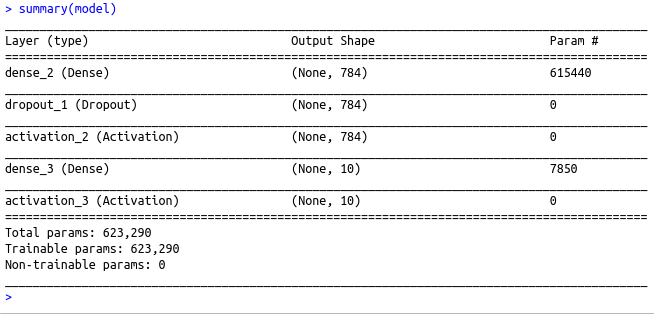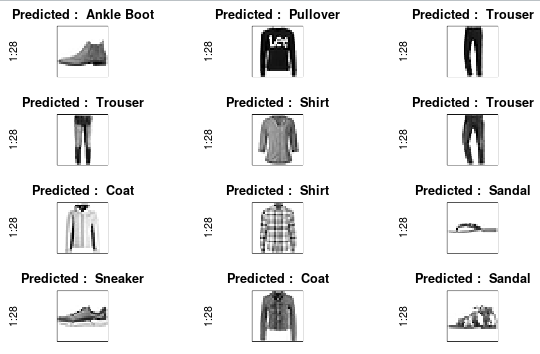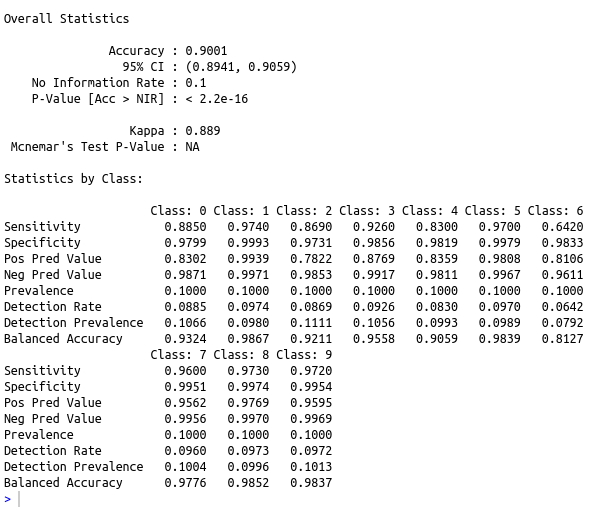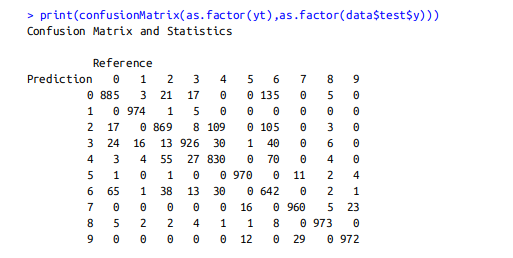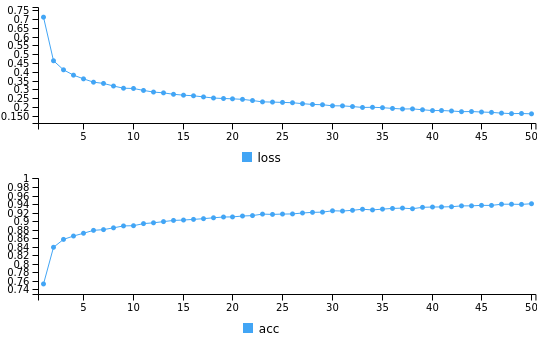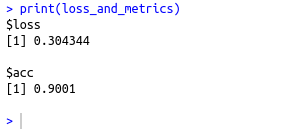To classify fashion articles using deep neural network in R
library(keras)
Load the necessary libraries
Load the data set
Convert the categorical variables to equivalent numeric classes
Split the data set as train set and test set
Initialize the keras sequential model
Build the model with input layers,hidden layers and output layer as per the data size along with the activation function(here 748 I/P layer with relu activation and 10 O/P layer with softmax activation)
Compile the model with required loss,metrics and optimizer(here loss=categorical_crossentropy,optimizer=adam,metrics=accuracy)
Fit the model using the train set
Predict using the test set
Evaluate the metrics
#loading keras library
library(keras)
library(caret)
#loading the keras inbuilt mnist dataset
data<-dataset_fashion_mnist()
#separating train and test file
train_x<-data$train$x
train_y<-data$train$y
test_x<-data$test$x
test_y<-data$test$y
# converting a 2D array into a 1D array for feeding into the MLP and normalising the matrix
train_x1 test_x1 #converting the target variable to once hot encoded vectors using keras inbuilt function
train_y<-to_categorical(train_y)
test_y<-to_categorical(test_y)
#defining a keras sequential model
model %
layer_dense(units = 784, input_shape = 784) %>%
layer_dropout(rate=0.4)%>%
layer_activation(activation = ‘relu’) %>%
layer_dense(units = 10) %>%
layer_activation(activation = ‘softmax’)
#compiling the defined model with metric = accuracy and optimiser as adam.
model %>% compile(
loss = ‘categorical_crossentropy’,
optimizer = ‘adam’,
metrics = c(‘accuracy’)
)
#Summary of the model
summary(model)
#fitting the model on the training dataset
model %>% keras::fit(train_x1, train_y, epochs = 50, batch_size = 1000)
#Evaluating model on the cross validation dataset
loss_and_metrics % evaluate(test_x1, test_y, batch_size = 1000)
print(loss_and_metrics)
#Predict using the Test data
yt=predict_classes(model,test_x1)
cat(“The confusion matrix is \n”)
print(confusionMatrix(as.factor(yt),as.factor(data$test$y)))
##Color ramp
colors<-c(‘white’,’black’)
cus_col<-colorRampPalette(colors=colors)
## Plot the average image of each digit
par(mfrow=c(4,3),pty=’s’,mar=c(1,1,2,1),xaxt=’n’,yaxt=’n’)
name1=matrix(c(“T-Shirt/Top”,”Trouser”,”Pullover”,”Dress”,”Coat”,”Sandal”,”Shirt”,”Sneaker”,”Bag”,”Ankle Boot”))
for(di in 1:12)#loading keras library
library(keras)
library(caret)
#loading the keras inbuilt mnist dataset
data<-dataset_fashion_mnist()
#separating train and test file
train_x<-data$train$x
train_y<-data$train$y
test_x<-data$test$x
test_y<-data$test$y
# converting a 2D array into a 1D array for feeding into the MLP and normalising the matrix
train_x1 test_x1 #converting the target variable to once hot encoded vectors using keras inbuilt function
train_y<-to_categorical(train_y)
test_y<-to_categorical(test_y)
#defining a keras sequential model
model %
layer_dense(units = 784, input_shape = 784) %>%
layer_dropout(rate=0.4)%>%
layer_activation(activation = ‘relu’) %>%
layer_dense(units = 10) %>%
layer_activation(activation = ‘softmax’)
#compiling the defined model with metric = accuracy and optimiser as adam.
model %>% compile(
loss = ‘categorical_crossentropy’,
optimizer = ‘adam’,
metrics = c(‘accuracy’)
)
#Summary of the model
summary(model)
#fitting the model on the training dataset
model %>% keras::fit(train_x1, train_y, epochs = 50, batch_size = 1000)
#Evaluating model on the cross validation dataset
loss_and_metrics % evaluate(test_x1, test_y, batch_size = 1000)
print(loss_and_metrics)
#Predict using the Test data
yt=predict_classes(model,test_x1)
cat(“The confusion matrix is \n”)
print(confusionMatrix(as.factor(yt),as.factor(data$test$y)))
##Color ramp
colors<-c(‘white’,’black’)
cus_col<-colorRampPalette(colors=colors)
## Plot the average image of each digit
par(mfrow=c(4,3),pty=’s’,mar=c(1,1,2,1),xaxt=’n’,yaxt=’n’)
name1=matrix(c(“T-
{
image(1:28,1:28,t(test_x[di,,])[,28:1],main=paste(“Predicted : “,name1[yt[di]+1]),col=cus_col(256))
}
